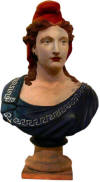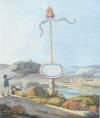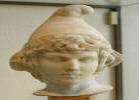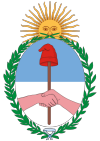The Origins of Liberty Poles in New York
A Liberty pole is a tall wooden pole, often
used as a type of flagstaff, planted in the ground, which may be
surmounted by an ensign or a liberty cap (see Phrygian cap below).
A liberty pole was often erected in town squares in the years before
and during the American Revolution (Newport, RI, Concord MA,
Savannah, GA, New York City, NY, Caughnawaga, NY). An often violent
struggle over Liberty Poles erected by the Sons of Liberty in New
York City (relating to the Battle of Golden Hill) and periodically
destroyed by British authorities (only to be replaced by the Sons
with new poles) raged for 10 years: from the repeal of the Stamp Act
in 1766 until the occupation of the city by British troops after the
Battle of Long Island in 1776.[1] The liberty pole in New York City
was crowned with a gilt vane bearing the single word, "Liberty".
When an ensign was raised (usually red) on a Liberty Pole, it would
be a calling for the Sons of Liberty or townspeople to meet and vent
or express their views regarding British rule. The pole was known to
be a symbol of dissent against Great Britain. The symbol is also
apparent in many seals and coat of arms as a sign of liberty,
freedom, and independence.
During the Whiskey Rebellion, locals in western Pennsylvania
would erect poles along the roads or in town centers as a protest
against the federal government's tax on distilled spirits, and
evoking the spirit embodied by the Liberty Poles of decades earlier.
The Arbres de la liberté ("Liberty Trees") were a symbol of the
French Revolution, the first being planted in 1790 by a pastor of a
Vienne village, inspired by the 1765 Liberty Tree of Boston. One was
also planted in front of the City Hall of Amsterdam on 4 March 1795,
in celebration of the alliance between the French Republic and the
Batavian Republic.
About the Phrygian cap
◄Bust of Attis wearing a Phrygian cap. The Phrygian cap is a soft, red, conical cap with the top pulled forward, worn in antiquity by the inhabitants of Phrygia, a region of central Anatolia. In paintings and caricatures it represents freedom and the pursuit of liberty.From Antiquity to the Normans. The Phrygian cap has two connotations: for the Greeks as showing a distinctive Eastern influence of non-Greek "barbarism" (in the classical sense) and as a badge of liberty among the Romans. The Phrygian cap identifies Trojans like Paris in vase-paintings and sculpture, and it is worn by the syncretic Hellenistic and Roman saviour god Mithras and by the Anatolian god Attis. The twins Castor and Pollux wear a superficially similar round cap called the pileus.
 In
Byzantium, Anatolian Phrygia lay to the east of Constantinople, and
thus in this late 6th-century mosaic from Sant'Apollinare Nuovo,
Ravenna (which was part of the Eastern Empire), the three Magi wear
Phrygian caps, identifying them as generic "easterners".►
In
Byzantium, Anatolian Phrygia lay to the east of Constantinople, and
thus in this late 6th-century mosaic from Sant'Apollinare Nuovo,
Ravenna (which was part of the Eastern Empire), the three Magi wear
Phrygian caps, identifying them as generic "easterners".►
In vase-paintings and other Greek art, the Phrygian cap serves to
identify the Trojan hero Paris as non-Greek; Roman poets habitually
use the epithet "Phrygian" to mean Trojan. The Phrygian cap can also
be seen on the Trajan's Column carvings, worn by the Dacians, and on
the Arch of Septimius Severus worn by the Parthians.
The Macedonian, Thracian, Dacian and 12th century Norman military
helmets had a forward peaked top design resembling the Phrygian cap.
The same soft cap is seen worn by an attendant in the murals of a
late 4th century Thracian tomb at Kazanlak, Bulgaria (illustrated).
In late Republican Rome, the cap of freedmen served as a symbol of
freedom from tyranny: a coin issued by Brutus in Asia Minor 44-42
BCE, posed between two daggers. During the Roman Empire the Phrygian
cap (Latin, pileus) was worn on festive occasions such as the
Saturnalia, and by former slaves who had been emancipated by their
master and whose descendants were therefore considered citizens of
the Empire. This usage is often considered the root of its meaning
as a symbol of liberty.
Revolutionary icon
 ◄Anonymous
bust of Marianne, with the Phrygian cap
◄Anonymous
bust of Marianne, with the Phrygian cap
A Phrygian cap on the Seal of the United States Senate.During the
18th century, the red Phrygian cap evolved into a symbol of freedom,
held aloft on a Liberty Pole during the American Revolutionary War.
The U.S. Army has, since 1778, utilized a "War Office Seal" in which
the motto "This We'll Defend" is displayed directly over a Phrygian
cap on an upturned sword.
The cap was especially adopted during the French Revolution, along
with other symbols adopted from classical Antiquity: to this day the
national emblem of France, Marianne, is shown wearing a Phrygian
cap. The bonnet rouge made its appearance early in the Revolution,
first seen publicly in May 1790, both at a festival at Troyes,
adorning a statue representing the Nation, and at Lyon, on a lance
carried by the goddess Liberty. In 1792, when Louis XVI was induced
to sign a constitution, popular prints of the king were doctored to
show him wearing the bonnet rouge. The bust of Voltaire was crowned
with the red bonnet of liberty after a performance of his Brutus at
the Comédie-Française in March 1792. By wearing the red Phrygian cap
the Paris sans-culottes made their Revolutionary ardour and plebeian
solidarity immediately recognizable; during the period of the
Terror, the cap was adopted defensively even by those whose politics
might be denounced as moderates or aristocrats and were especially
keen to advertise their adherence to the new regime.
The cap was also incorporated into the symbol of the late 18th
century Irish revolutionary organisation the Society of the United
Irishmen.
American symbolism.
Many of the anti-colonial revolutions in North and South America were heavily inspired by the imagery and slogans of the American and French Revolutions. As a result, the cap has appeared on the coats of arms of many Latin American nations. An effigy of "Liberty" was shown holding the Liberty Pole and Phrygian cap on some early United States of America coinage (pictured right). It also appears on the State flag of West Virginia, New Jersey and New York, as well as the official seals of the United States Army, the United States Senate (left), the arms of the North Carolina Senate, and on the reverse side of the Seal of Virginia. The cap had also been displayed on certain Mexican coins (most notably the old 8 Reales coin) through the late 19th century into the mid 20th century. Today, it is featured of the coats of arms or national flags of Nicaragua, El Salvador, Argentina, Colombia, Haiti, Paraguay and Cuba. Coat of arms of Argentina►
In 1854, when sculptor Thomas Crawford was preparing models for sculpture for the United States Capitol then Secretary of War Jefferson Davis (later to be the President of the Confederate States of America) insisted that a Phrygian cap not be included of a statue of Justice on the grounds that, "American liberty is original and not the liberty of the freed slave." The cap was not included in the final marble version that is now in the building.
The seal of Dickinson College, in Carlisle, Pennsylvania, also contains a Liberty Cap. The college, endowed by Founding Father John Dickinson at the behest of Benjamin Rush, was the first to be chartered in the new Republic.
Washington Irving also propounded the surprise of his famous protagonist, Rip Van Winkle, by noting among the unexpected details of the re-awakened Rip's newly post-revolutionary village a "tall naked pole, with something on it that looked like a red night cap..."
List of national coat of arms that include Phrygian caps
Coat of arms of Argentina
Coat of arms of Bolivia
Coat of arms of Colombia
Coat of arms of Cuba
Coat of arms of El Salvador
Coat of arms of Haiti
Coat of arms of Nicaragua
Medical term
Phrygian cap is also a term used for an anatomical variant of the gallbladder seen in 1-6% of patients who have ultrasound exams or contrast studies of their gallbladders. It is caused by a fold or division at the point where the tip of the gallbladder (the head) joins the main part of the gallbladder (the body), and is named for its resemblance to the cap above. Apart from being the chance of being mistaken for stones on ultrasound, it has no other medical implications nor does it predispose one to other diseases.
Literary references
The revolutionist protagonists of Robert A. Heinlein's The Moon Is a Harsh Mistress often wear a liberty cap. It is referred to exclusively as such. It becomes a fashion article at one point, and is once placed on a telephone terminal open to the A.I. character "Mike."
The popular cartoon characters The Smurfs, are famous for their white Phrygian caps.
Cornish piskies wear Phrygian caps symbolising proto-Celtic origins and magical powers in Mystic Rose - Celtic Fire by Toney Brooks.
The song "Then She Appeared" by rock group XTC contains the line "Dressed in tricolour and Phrygian cap"
Home |
Site History |
Liberty
Poles |
Live Web Cams
| Gallery |
Rochester Gifts |
Contact
Copyright © 2007-2012 TheLibertyPole.org. All Rights Reserved.





